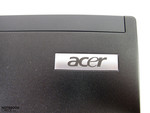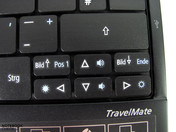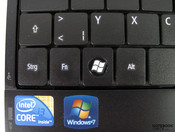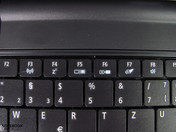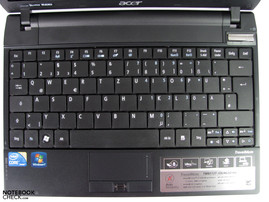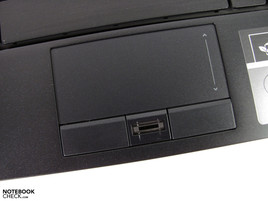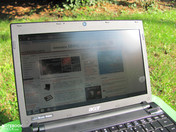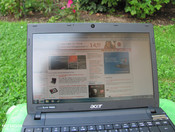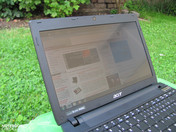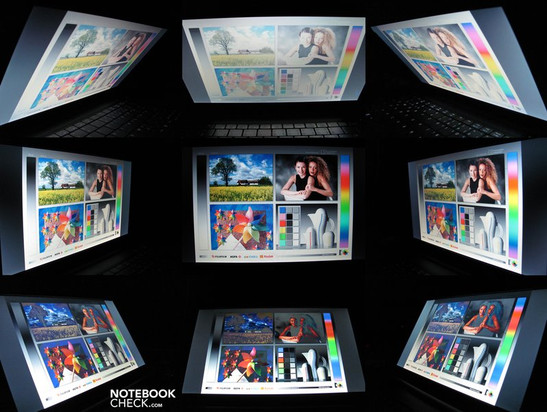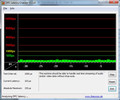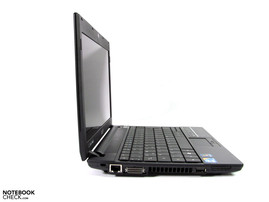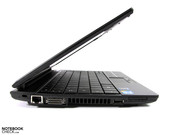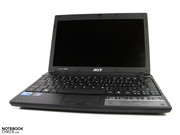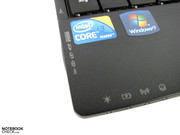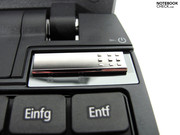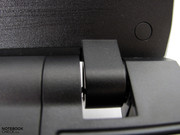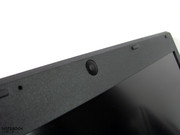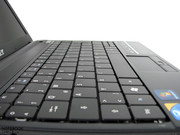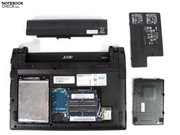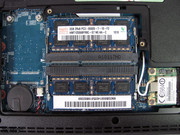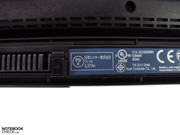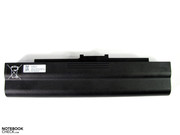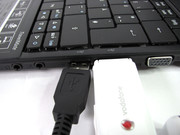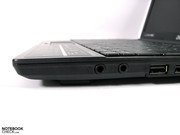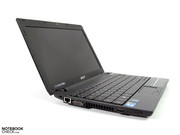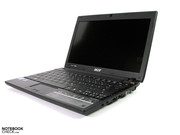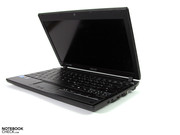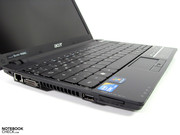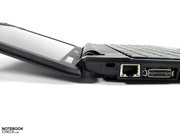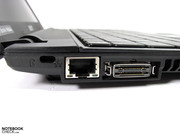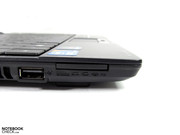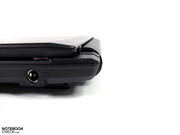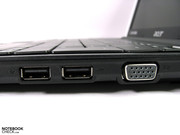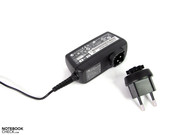Review Acer Travelmate 8172T Notebook

Unlike in Germany, the first Timelines of the Travelmate series were available in the 11.6" format in the UK. Our German friends only now get this device size in the revised variant, which is getting ready to make a bang not only in the business sector but also among some home users. The chassis is on a netbook level; long battery life and acceptable performance ability are combined with a matte 11.6" display, which altogether are rarely to be seen in the product portfolios of manufacturers.
Our test model is equipped with an Intel Core i3-330UM CPU, Intel HD graphics, 320 GB hard disk and 4 GB DDR3 RAM. The most apparent competition is the Lenovo X100e with Turion X2 Neo L625, if you consider the form factor, combined with the matte WXGA display to be main criteria. Alternatively there's still the Samsungs N510 with an Atom CPU and ION graphics, which above all comes up with a clearly more attractive price.
The street price of our test model (LX.TWN02.003) is currently around 660 Euro (plus shipping) and is thus somewhat more expensive than the competition with AMD technology which, for just under 630 Euro, even brings along an UMTS module, but nevertheless has "only" 3 GB of RAM (Lenovo X100e NTS5GGE) and also weighs around 100g more. The basic model of the Travelmate 8172T with a somewhat different equipment starts at 600 Euro (2GB RAM, 160 GB hard disk) and the flagship model, at 800 Euro, has an integrated UMTS module.
Case
In keeping with the product positioning, the Acer Travelmate 8172 comes without high-gloss surfaces at all and is presented in a business-class standard matte-grey. Alternative colours, for example on the Lenovo X100e or the Aspire 1830T, are not available.
The weight we measured as 1390 g, which is minimally above the manufacturer's claims (1350 g), but still, together with the compact dimensions of 285 (W) x 206 (D) x 29 (H) mm, provides for good mobile basic characteristics.
The surfaces are slightly rough, finished with a mottled grey look on the display lid, and make a tough and low-maintenance impression. Fingerprints, dust and stress marks are well concealed and require only the occasional cleanse. The strength of the case material, together with the solid substructure, leads to a very good torsional strength. Wrist rests and also the usually delicate areas around the battery don't show any weaknesses. The keyboard didn't reinforce this very good impression, which is somewhat bendable in the middle and is thus slightly bouncy. The display lid, on the other hand, can be warped much less than the models of many competitors and can also be considered more stable than average. Through pressure on the borders or on the lid we couldn't provoke any image alterations.
The display hinges are just as flawless. A see-sawing is noticed just as little as inaccuracies in fit and creaking noises, which we have observed before on other Acer laptops.
The under-body as always presents itself with several openings for different components like hard disk, RAM and wireless module. The battery sits firmly and can also be removed when the system is running from the mains without a negative influence on the stability of the case. The feet are mounted directly on the case and prevent as is usual any slipping on different surfaces.
Connectivity
Apart from the Easyport IV docking connection and a fingerprint reader - typical of business - the Acer Travelmate 8172T only offers standard fare by way of interfaces. 3x USB 2.0, Gigabit-LAN, multi-card reader, VGA, WLAN 802.11b/g/n, webcam, audio and Kensington Lock cover the basic needs. Bluetooth stands out with the supported standard 3.0+HS, yet lacking fitting peripherals we couldn't thoroughly test this.
The interface quality doesn't quite conform to the average with a maximum of 25.4 MB/s (USB 2.0) and 16.3 MB/s (SD card). Only the 6.9 MB/s of the xD card is somewhat better than usual. In particular, external hard disks are consequently thwarted over USB 2.0 and cannot reach the otherwise usual 28-30 MB/s. All the same the transfer rates remain on the same level when away from the mains and don't fall because of energy-saving reasons.
The analogue VGA port provided a satisfactory image on an external display at a resolution of 1280x1024. Slight fuzziness is soon seen, yet the display allows for occasional work. We didn't test higher resolutions.
On the Travelmate, the optical drive has to be done without, along with fast interfaces like FireWire, eSata or USB 3.0. Also the latter cannot be retrofitted via ExpressCard, as the corresponding slot is simply not present. A digital video output is only possible via the optional Easyport IV docking add-on, which alongside DVI-D also makes VGA, USB 2.0, audio and Gigabit-LAN available. The surcharge is around 100 Euro.
The positioning of the connections found on the device is, depending on preference, successful. VGA, Dockingport (Easyport IV), power supply and LAN are to be found far to the rear and with connected peripherals only disturb in the rarest of cases. USB Ports, card-reader and audio connections are accommodated further to the front and are thus easily accessible. With connected devices like hard disks, headset and Co. in the front, the different cables can get in your way, especially when using a mouse.
Windows 7 Home Premium 64-bit is the operating system installed. The 4 GB DDR3 RAM present can thus be fully used. More noteworthy software isn't included. Only the well-known test versions of Microsoft Office and McAfee are to be found and are additionally shown off as advertising posters on the display borders.
Input Devices
Keyboard
The keyboard has large keys in a 19 mm grid which are easy to get used to through their pleasant stroke. With a short stroke and quiet operating noise, longer input sequences are a joy. Only the space key gives off a rather rickety noise which, as always, is down to its size. The substructure is on the whole very solid, but cannot completely prevent bending towards the middle. However, we didn't observe any negative effects on typing, as bounciness on the keyboard could only be provoked with very hard strokes.
All important keys are sufficiently sized and can be used accurately, apart from the somewhat small arrow keys. The layout on the whole corresponds to the usual standard and is no puzzle to be worked out. Important functions are as always accessible via combinations of the FN key and additionally facilitate the day-to-day operating. The keyboard inscription is high in contrast and thus visibility is good in bad lighting conditions.
Touchpad
The too-small touchpad at the netbook level wasn't quite so pleasing, which either doesn't respond to input or when forcefully used, responds twice as much as required. Here you have to learn the ropes somewhat longer, or perform some fine-tuning in the settings, in order to find the right enduring pressure point. Otherwise the sensitive surface has good gliding qualities with precise cursor navigation. The touchpad keys are to be found on almost the same level as the wrist rest area, and accommodate the fingerprint scanner in the middle. This is also somewhat small, yet it fulfils its purpose properly.
Display
Acer uses an 11.6" HD-display with LED background illumination in the Travelmate 8172T. The WXGA resolution of 1366x768 pixels clearly provides a bigger image area compared to netbooks with the standard WSVGA resolution (1024x600 / 117 dpi), yet with a dpi of 135 it has the disadvantage of an even smaller symbol- and button-size. In the meantime you can compensate for this well with an adjusted (enlarged) rendering of windows and scripts in the system settings. As not every program supports this feature completely, you should, when considering the rendering size of your main program, test the compatibility beforehand.
| |||||||||||||||||||||||||
Brightness Distribution: 85 %
Center on Battery: 195 cd/m²
Contrast: 188:1 (Black: 1.04 cd/m²)
The built-in panel from AU Optronics (AUO215C) has an anti-glare surface, but cannot be compared with the conventional 'matte' displays. Slight scattered reflections (silhouettes) are observed depending on the incidence of light, yet these are by far not as strong and irritating as is the case on models with glossy displays.
Outdoor use is possible thanks to the measured brightness value, which adds up to 192 cd/m² on average. For outside appointments the good legibility of the screen contents from different positions also subjectively confirms the measurements.
On almost all of our nine measurements the display reaches a luminance of over 190 cd/m², only the left upper corner drops down to 167 cd/m² and decreases the otherwise record illumination to 84.5%. This brightness decrease is admittedly only visible in monochrome backgrounds, if at all.
The colour spectrum doesn't go beyond 55% of the sRGB spectrum and thus corresponds to the level of the other standard laptop displays. Also the contrast ratio measured by us is in line with the trend at 184:1 and causes little excitement. The colours seem pale with low saturation and the blackest of black is searched for in vain.
The horizontal viewing angles are very stable and allow good visibility of screen contents from all angles. Also colours and brightness change relatively little when you change your position. Vertically, we come across the standard clearly lower viewing angle stability, which causes a noticeably strong change to the presentation of the display. Brightness- and colour-shifts appear early, eventually ending in an inverted or bleached image. This is evidenced only from extreme viewing angles, and then only with great difficulty.
Performance
The Travelmate 8172T is equipped with Intel's H55 Express chip-set and has a very energy-efficient laptop CPU in Intel's Core i3-330UM. Inclusive of the integrated Intel HD graphics, the processor has a maximum TDP of 18 Watt and thus clearly uses less energy than the other Core i3-xxxM processors with their TDP of 35 Watt.
The nominally low clock speed of 1.2 Ghz leads one to expect an extremely low performance on first glance, especially as the model at hand has no Turbo Boost (automatic overclocking in certain load scenarios). Nevertheless the Hyperthreading technology (2 additional cores provide simultaneous processing of a maximum of four threads) and the 3MB L3 cache help to create a day-to-day fluid work speed. Only in energy-saving mode the system feels somewhat sluggish, as the CPU as a general rule underclocks to 666 Mhz and only reluctantly increases over the levels 800 Mhz and 1000 Mhz to the maximum possible 1.2 Ghz.
In all of the benchmarks carried out by us, the AMD Turion Neo L625 (Lenovo X100e) with 2x 1.6 Ghz is in parts clearly beaten. Thus the Core i3-330UM reaches 1700 points (single) and 3779 (Multi) in Cinebench R10, the wPrime1024 computation takes place in 1310 seconds and superPi 32m is completed after 1843s seconds. For this reason you reach the performance level of a Core 2 Duo T5500 CPU, which for an ultra-low-voltage model is already quite considerable. For a comparison, see our extensive CPU benchmark list.
In our practice tests we have again let some audio- and video-data encode. With iTunes (single-core heavy) our test songs were converted at 13.6x speed from MP3 into the AAC format and with Mediashow Espresso (multi-core) we converted our test data (full HD trailer 300) at a CPU load of 86% in 159 seconds into an iPhone compatible H.264 format. The Thinkpad SL510, with a T6570 CPU, needed 142 seconds for this video encoding. Thus the Core i3-330UM CPU can hide the very low clock frequency very well, especially on multi-core tasks. The other usual office-, internet- and communications-programs run fluently and also allow using several applications concurrently.
The Intel HD graphics integrated into the CPU case can dynamically increase its basic core speed of 166 Mhz to 500 Mhz according to requirement and accommodates the energy-saving designations. Indeed we didn't expect any 3D performance; nevertheless the first results were greatly disappointing. 838 points in the 3D Mark `05, 419 points in the 3D Mark `06 and 476 points on Cinebench OpenGL Shading are by a margin the worst graphics performance values that we have ever measured with Intel HD.
As we test out all possible performance settings whilst troubleshooting, we suppose that the Intel HD graphics only works at the basic speed of 166 Mhz. This was also confirmed by the Tool HW32. Only after we had downloaded and installed the Intel Turbo Boost driver from the Acer support site did the GPU run as it should, up to 500 Mhz. Unusually, we were until now of the opinion that this would have to work with the GPU without drivers. Acer was also of this opinion, as this wasn't pre-installed on the test device.
The re-measured value now corresponds completely to what Intel HD graphics would normally achieve. 2303 points in 3D Mark `05, 1142 points in 3D Mark `06 and 1178 points on Cinebench OpenGL Shading look a lot better. Also on 3D Mark Vantage the feeble 11 little points are replaced by 132.
Full HD videos can be played without judders with a DXVA-capable player, like MPC Home Cinema. We tested it with different full HD trailers and the film Big Buck Bunny and Elephant's Dream. The CPU load was between 30 and 50%.
With the tool DPC Latency Checker we checked for potential conflicts with external devices due to faulty synchronisation. The values obtained by us are all far into the green and so peripherals will cause no kinds of problems.
| PCMark Vantage Result | 3680 points | |
Help | ||
We obtained the application performance with the benchmark PC Mark Vantage and reached a result of 3307 points - not bad. With a normally working GPU the result increased to 3680 points. Thus the competition with Intel Atom or AMD-Neo X2 CPUs is clearly outperformed. Also many CULV laptops of the last generation can be easily left behind, which makes for a more-than-office capable performance.
| 3DMark 03 Standard | 3259 points | |
| 3DMark 05 Standard | 2303 points | |
| 3DMark 06 Standard Score | 1142 points | |
| 3DMark Vantage P Result | 132 points | |
Help | ||
The Acer Travelmate profits in many areas from a good conventional hard disk. The model wins us over less through sheer performance, but rather through a successful combination of speed, energy consumption and operating noise. The Toshiba MK3265GSX (1 platter), with a capacity of 320 GB, works at a speed of 5400 RPM and has 8MB cache. The average transfer rates are around 67 MB/s and at most reaches up to 90 MB/s. Here, many a hard disk running at 7200 RPM is outpaced. The access time is more average at 17.1ms. The energy consumption is, according to the manufacturer, 0.55 Watt when idle and 1.5 Watt when reading and writing, which are very good values and work in harmony with the achieved battery life measurements.
Emissions
System Noise
The Travelmate remains almost completely inaudible in energy-saving mode. The very quietly running fan is drowned out by the already very quiet hard disk when accessing the drive. We measured only 29.3 dB(A) when idle; when the hard disk joins in the noise level increases to a maximum of 31.4 dB(A). If you change the energy profile to balanced or high-performance the level is only slightly louder when idle or with low load at 31.1 dB(A). This corresponds, for example, to internet surfing with several tabs, text documents and iTunes music playback simultaneously. When converting MP3 data or playing full HD videos the fan increases to a still moderate 34.8 dB(A). Only very rarely does the load of the fan get one level higher, yet it very quickly gets quiet again.
Under full load it becomes unpleasant after a while as users have to put up with 41.2 dB(A). This state is reached by concurrently running Furmark and Prime95, but also during lengthy conversion of videos with Cyberlink's Mediashow Espresso, where we had a steady 85% processor load.
We reached this overall low noise occurrence under low and medium load on the test device on a continuing basis only after changing the settings in the graphics menu. In battery mode the high performance of the graphics chip was preset, which on the one hand led to an unnecessarily high performance increase (see battery life) and on the other hand caused a partly fidgety fan in energy-saving mode.
Noise Level
| Idle |
| 29.3 / 31.1 / 31.1 dB(A) |
| HDD |
| 31.4 dB(A) |
| Load |
| 34.8 / 41.2 dB(A) |
 | ||
30 dB silent 40 dB(A) audible 50 dB(A) loud |
||
min: | ||
Temperature
The heat development of the test device under load no longer appears suitable for use on the lap due to more than 47°C on the left underside of the case (region of the fan outlet). In this load situation, standard use on a desk is nevertheless no problem. In normal operation we measured a clearly lower heat development with just under 37°C, and thus shouldn't be a problem for use on the lap.
(±) The maximum temperature on the upper side is 41.1 °C / 106 F, compared to the average of 35.9 °C / 97 F, ranging from 21.4 to 59 °C for the class Subnotebook.
(-) The bottom heats up to a maximum of 47.5 °C / 118 F, compared to the average of 39.3 °C / 103 F
(±) In idle usage, the average temperature for the upper side is 32.3 °C / 90 F, compared to the device average of 30.8 °C / 87 F.
(±) The palmrests and touchpad can get very hot to the touch with a maximum of 37.6 °C / 99.7 F.
(-) The average temperature of the palmrest area of similar devices was 28.2 °C / 82.8 F (-9.4 °C / -16.9 F).
Loudspeakers
The loudspeaker output is on a similar level as that of usual netbooks or other subnotebooks. High notes dominate, whilst weak middles and almost inaudible bass characterise the sound. Earphones should thus be in your backpack when travelling and when stationary you will get a real improvement through additional external speakers.
Battery Life
The Acer Travelmate can be equipped with three different batteries, according to Acer documentation. Here there's a 3-cell battery with a capacity of 24 Wh, a 6-cell battery with 48 Wh and, as present in the test device, a 6-cell battery with a capacity of 63 Wh.
The consumption values that we obtained impressively show the energy-saving potential of the deployed components. 5.8 Watt when idle with minimum brightness and switched-off energy hogs like WLAN marks the lowest consumption level. With maximum brightness and balanced energy-saving profile, the power consumption increases to an all-the-while good 8.5 Watt. This is gradually increased according to demand up to a maximum of 29 Watt, which for full load is in any case a very good value.
When changing from the mains to the battery, you have to get used to some quirks on this Acer. The energy scheme changes automatically when unplugging or plugging in the power supply and the WLAN module switches itself on again after a reboot new start, whereas Bluetooth still remains turned off. We didn't find any individual adjustments. These Acer tools really don't seem thoroughly thought through, but can be uninstalled really quickly.
| Off / Standby | |
| Idle | |
| Load |
|
Key:
min: | |
In the first battery life measurements that we carried out, we were obviously surprised. The Travelmate 8172T reached no more than 322 minutes in the Battery Eater Readers Test (maximum possible battery life with all energy-saving options and minimum brightness, additional energy hogs like WLAN turned off). This equates to a consumption of 11.7 Watt and downright doesn't correspond to our value reached on the mains, which was 5.8 Watt. A mistake in the settings for the energy-saving profile wasn't present, which made another trouble-shooting session necessary.
After various tests and different settings which didn't reach the goal, we found the problem in the energy settings of the Intel graphics driver. Nonsensically, the maximum performance instead of the maximum battery life when running from the battery was preset. Consequently the graphics chip ran with full energy uptake, even in energy-saving mode, although the energy-saving mechanisms should be effective. However, the fact that the installation of the Turbo Boost driver and the associated performance increase, as explained in the performance chapter, didn't affect the energy consumption under full load (Battery Eater Classic) remains a mystery. The battery life in this scenario remained almost identical.
Changing the setting in battery mode finally led to the beginning of hoped-for battery life. For the Battery Eater Readers Test this meant a scope of a maximum of 641 min and in the Battery Eater Classic Test (minimum possible battery life, all energy hogs on, profile high performance) we reached a battery life of 180 minutes (previously 181 minutes). For WLAN surfing the system lasted 348 minutes and for films stored on the hard drive, 244 minutes. These are, on the whole, very good values, and this finally confirms the Acer Travelmate as a very successful mobile computer.
Edit: On the bequest of a reader, a subsequent test with an external UMTS USB stick (Huawei E160) on the O² network (HSDPA) reached a battery life of 306 minutes (3% battery remaining capacity). There we used the balanced profile and maximum display brightness.
Verdict
The rather great potential of the Acer Travelmate 8172 was really undermined on the test device by an unusually flawed configuration. A faulty driver installation and a driver not even installed on the one hand provided an unusually short battery life and on the other hand led to very weak graphics performance. After correcting these problems the subnotebook could fully display its strengths in battery life and its standard graphics performance.
Apart from this faux pas and some rather unhelpful Acer Tools, the test device delights with a very good case quality, a very good keyboard, a low weight and some business specialities like docking connection and fingerprint reader. The outdoor-ready display with a matte surface is on the whole good quality and well suited to target consumers. The system performance is surprisingly high despite the deployed energy-saving components and should be able to cope well with most tasks in the business and home office realms. Even with the correctly functioning graphics unit, the system is not suited for demanding 3D animations or current 3D games.
The lack of a fast interface like eSATA or USB 3.0 or the ExpressCard slot necessary for upgrades wasn't pleasing. Additionally some of the ports are weak, like USB 2.0 and SD card, with a comparatively low performance which demands longer waiting times than usual. The touchpad is too small for substantial use and a digital video output remains reserved to the consumer variant Aspire 1830T.
All in all the Travelmate 8172 is a joyfully versatile and extremely mobile companion, which will surely find many fans with a good performance and a comparatively low price.




